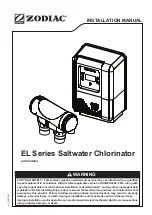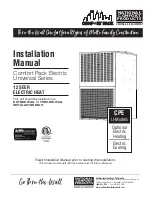
Copyright © 2014
Ikhwezi Solar (Pty) Ltd, Novatherm CC, Solar Assist (Pty) Ltd
14
Once you get used to the system and its
optimum performance pattern, you may
eventually completely switch the electrical
backup off, particularly in summer months.
An additional benefit of this is that it is the
fastest way to reduce the system’s payback
period.
Savings can be further maximised by using
hot water in the evening rather than in the
morning, maximising the free energy
harvested during the day.
Additional tips to enhance savings include:
To further optimise energy and hot water
savings, install aerated shower heads and
aerators in taps to reduce hot water
consumption.
Insulate hot water piping to minimise heat
losses.
Showering generally uses less water than
bathing.
For health reasons your hot water system
should provide water at 55ºC, but not much
warmer than that. Do not set your thermostat
backup temperature control for temperatures
in excess of this.
If shading of collectors is experienced
between 9am and 3pm then corrective action
should be taken. Annually prune or cut trees
that shade the system.
Partial shading by chimneys, TV antennas,
roof erected fixtures, etc. on buildings during
these hours is acceptable provided that it
does not exceed 10% of the area. Shading
from newly erected buildings should be
checked and if system performance is
affected, relocation of the system may be
necessary.
13.3
Over-night temperature stabilisation
Over-night temperature stabilisation is the
reduction in water temperature, as the hot
water at the top of the storage cylinder
transfers some of its heat to the cooler water
in the lower section of the cylinder.
This effect is often perceived as heat loss, but
is actually the redistribution of stored heat
more evenly over the entire contents of the
storage tank. This may make it necessary to
use the electric element to raise the water in
the top section of the cylinder back to an
acceptable temperature.
Over-night temperature stabilisation is most
evident in the morning if the time clock is left
off overnight.
13.4
High water temperature
Your solar water heater will generate hot
water quickly and efficiently. Under normal
family use, it will operate between 60ºC and
70ºC. However, the temperature can exceed
this and under certain circumstances may be
as high as 95ºC. This can occur during
prolonged periods of direct sunlight and
particularly in summer or long periods of
reduced water usage. Extreme care should be
taken in these circumstances.
Although every system is fitted with a mixing
valve that regulates temperature at points of
water use, check the water temperature
before use, such as when entering a shower
or filling a bath or basin, to ensure it is
suitable for the application and will not cause
scalding. It is required by SANS regulations,
that a temperature limiting device / mixing
valve be fitted to the system. This will limit
the water temperature to 50°C at the point of
use. The risk of scalding will be reduced, but
water should always be tested prior to use to
prevent injury in the case of a tempering
valve failure.
13.5
Periods of reduced usage or holidays
If the water heater is left unused for two weeks
or more a small quantity of hydrogen gas, which
is highly flammable may accumulate in the top of
the water cylinder. This is true of both






































